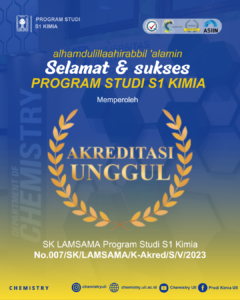The Chemistry Study Program (CSP) employs a systematic process to examine its teaching and learning methods (such as class lectures and lab work) as well as research activities (in the form of apprenticeships and final projects for bachelor’s theses). Every type of exam is planned and managed based on a continuous improvement process in order to maintain quality assurance. Having different CLOs, each activity is subject to a unique examination process prior to the commencement of activities in the following semester or academic year. Hence, the CSP ensures that each module abides by the most suitable exam model to measure the relative achievement of CLOs for each student.
Examinations or evaluations are conducted based on the outcomes of prior activities. For lab work, which is related to professional skills, evaluations are performed by conducting pre- and post-tests. For courses, evaluations and assessments are performed with reference to tasks enshrined in the CLOs. Such evaluations include paper tasks, group discussions and presentations, project assessments, etc. The administration of these evaluations fulfills the ECTS and is thereby sufficient to the student’s capability and time.
Meanwhile, the final marks for each course appropriately refer to the corresponding university regulation (05/PR/REK/BPA/III/ 2014). Specifically, for the apprenticeship and final project, the CSP provides a guidebook for apprenticeship and a final project book, respectively, that are composed of regulations for the implementation of activities and marks. Concerning the final project, the evaluation covers the capability of students to managerially handle tasks on their own in laboratories, to comply with laboratory safety protocols, to master basic theory, and to develop innovative and collaborative skills. All evaluations and marks for all courses and activities are matched with the PLOs.
Moreover, the CSP has a strict regulation concerning the feasibility of access to teaching, learning, and research activities, during both ongoing processes and examinations, when, for example, a student is ill or is attending a competition or conference. For lab work, the apprenticeship, and the final project, the regulation stated in each guidebook permits students to re-sit exams due to such limitations. Meanwhile, for class courses, the regulation is set by the university and faculty examination committee, and is published regularly by the start of each activity. These regulations are in place to guarantee the quality and efficient functioning of education so that all students can achieve the predetermined CLOs.
Thus far, the examination process has not had a negative impact on the progress of student studies because all exams have been integrated and managed by the faculty through the examination committee; therefore, all technical regulations have been considered, as have the effects of matters related to students’ learning development. Such integrated management will accelerate graduation rates because the timely administration and correction of exams are strictly monitored and controlled.
In terms of the assessment criteria, the CSP abides by the principles of fairness and transparency for both students and teaching staff. The assessment criteria can be reviewed by students and teaching staff in the form of course detail documents as well as in apprenticeship and final project assessment documents. Furthermore, teaching staff should carry out a verification process for every question on the exams to ensure compliance with syllabus requirements and CLOs and should return corrected exams to students in a timely fashion so that the students can confirm their marks and discuss them with their lecturers, if need be. In addition, the CSP also employs external examiners to review the content and suitability of exams with respect to the CLOs.
Two student assignments are completed outside the jurisdiction of the CSP: the apprenticeship and the community service program. For these two assignments, the relevant department provides a guidebook containing its assessment criteria and the name of the person charged with carrying out the assessment in order to maintain the quality and transparency of the program.




